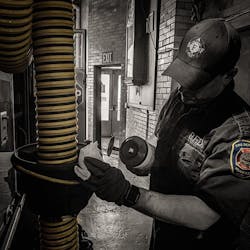You’ve heard about fire station “hot zones"; red for contaminated areas (apparatus bays); yellow for transitional areas (airlocks); and green for (contaminant free) living areas.
However, the new COVID-19 virus is color-blind and defies boundaries. After following protocols to leave PPE and equipment in the bay area, most responders likely head for the living area, grab something to drink and plop down in a recliner.
Wait.
Did you sneeze into your elbow that is now resting on the recliner? Did you forget to wash your hands after taking off your gear and opening the refrigerator or cabinet to get a cup?
We checked with several manufacturers of items in fire stations requiring special cleaning or disinfectants amid the current pandemic.
In the apparatus bays, Bryan Reeves, fire segment manager for Plymovent, recommends additional safety measures to protect first responders during these uncertain times.
“The Plymovent exhaust system is the first piece of equipment handled/touched when first responders return to the station. We recommend cleaning or wiping down the systems’ exterior with a disinfectant such as Clorox wipes or similar that have been approved by the Environmental Protection Agency (EPA) to use against COVID-19,” said Reeves.
“This should be done on a daily basis in high-touch areas, such as the yellow and black flexible exhaust hose below 6-feet, the safety disconnect handle, the manual fill and deflation valve and knob if it is a Pneumatic Grabber System, the lower 2-foot yellow and black hose above the Grabber Nozzle that connects to the vehicles exhaust, and the face of the automatic exhaust blower control unit.”
Cleaning around their facility has become a top priority, according to Bob Foht, president of GearGrid Corporation. “I can only imagine what it’s like in a fire station you share with others,” he said.
Racks for turnout gear are often overlooked in routine cleaning, but with the rampant COVID-19 outbreak, assuming the surfaces are powder-coated steel, Foht suggested three steps to disinfect the racks for turnout gear:
- Put on proper PPE when performing the cleaning process, including but not limited to disposable gloves, eye protection and gowns compatible with the disinfectant used.
- Scrub dirty surfaces with a detergent or soap and warm water and then dried prior to a disinfectant being applied.
- Wipe down powder-coated metal surfaces with a bleach/water combination (1/3 cup of bleach per gallon of water). Apply using a cloth and where required, a spray bottle on harder to access areas such as wire shelves, avoiding direct contact with firefighter PPE. Let sit for approximately 10 minutes before wiping off.
The fire station’s laundry area also requires extra attention. Scott Peregoy, regional sales manager for Unimac/Alliance Laundry Systems, recommends departments follow the procedures provided in NFPA 1851, Standard on Selection, Care, and Maintenance of Protective Ensembles for Structural Fire Fighting and Proximity Fire Fighting, 2020 Edition.
“Due to the current situation, we are also encouraging fire station laundries to run sanitization cycles between loads as a precautionary measure,” said Peregoy. “Although time and temperature methodology following CDC guidelines are one way to kill viruses, a more practical way is to use an effective disinfectant.”
Suitable disinfectants are registered under EPA Registration Number 1839-166 or 1839-169.
“Three examples of such products popular in the fire market for PPE disinfecting are marketed under the names Pro Quaternary by Clorox Corp, GS Neutral by Spartan Chemical, and Strike-Bac by GenLabs,” said Peregoy. “There may be other products registered to these EPA Registration Numbers but marketed under different names which would also be suitable.”
If the pandemic virus extends, departments should use all available methods to reduce risks. The CDC suggests COVID-19 is more transmittable than most flu viruses. Thus, any direct contact with patients is a potential exposure. Handling potentially exposed gear presents an elevated risk.
“We are encouraging departments to clean and disinfect at the scene to the best of their ability," Peregoy said. "After that, follow a protocol of red bagging potentially exposed gear at the scene after any potential exposure, and then conduct an immediate specialized cleaning with a disinfectant wash cycle in a washer extractor back at the station.”
In addition, disinfecting hard surfaces in department laundry facilities should be undertaken on a regular interval.
“All surfaces in the laundry should be targeted, including holding bins, tables, drying racks, and the room surfaces as well to reduce the risk of contamination from exposed surfaces,” Peregoy said.
Sleeping areas are another area to be considered. The CDC recommends following standard operating procedures for containing and laundering used linen and to avoid shaking the linen.
“When it comes to the cleanliness of the bedding and mattress, it starts with personal cleanliness," said Travis Hedlund, sales manager for Sleep Number. "Taking a shower before going to sleep or naps is encouraged, warm showers are also a great way to help engage relaxation to help you fall asleep. The next step is washing all your bedding regularly--sheets, pillowcase, mattress pads, and bedding. I encourage all firefighters to have their own mattress pad and wash that with your sheets.”
Hedlund advised, “During this time of social distancing and the overwhelming exposure to media and social feed updates, it’s important that we take time to recharge our mind and body. One of the best ways to do this is sleep! When able, take a nap instead of watching TV or looking at your smart device. Prioritize your wellness during this time, maintain your workouts, eat healthy, and stay rested!”
Recliners, chairs and sofas are available in leather-like or microfiber materials. How do you clean these heavily used items? All furniture surfaces inside the living area should be cleaned according to the manufacturer’s recommendation.
Brandon Dunn, president of Working Fire Furniture & Mattress Co., Inc., explained they always recommend general furniture cleaning as part of the routine station duties.
“However, this virus presents a serious threat that commands a different approach to cleaning,” Dunn said.
“Most true disinfectants can potentially harm recliner and sofa fabrics, but mild soap and water can generally be used to clean the surface. Some materials can be cleaned with a mild disinfectant solution, which has a greater effect than the soap and water. Care should be taken to not use harsh disinfectants on delicate fabrics,” Dunn added.
“We recommend removing outer bedding and storing inside a container when not being used,” said Dunn. “Sheets and pillowcases should be washed as often as possible, preferably after each shift. This is where multiple sets of bedding can come in handy. And mattress protectors should always be used, regardless of the situation.”
“These are, in fact, tough times. We recommend that extra precautions be taken to prevent spread of this disease, including more thorough and regular cleaning of the furniture. Departments should outline the expectations of cleanliness of the living quarters, just as they would with their rigs. Lead by example and take all precautions necessary to protect the health and safety of their crews.” Dunn said.
On recliners made of microfiber material, Phil Catalani, Sales, Dreamseat, LLC., cautioned, “The problem with microfiber is it is a breathable cloth, while you can clean the outside, virus and pathogens can get into the foams.” For fire stations, Catalani recommends synthetic leather that is anti-microbial and anti-bacterial as a much better option. “Synthetic leather can be cleaned and there is no worry about a liquid getting into the chairs,” he said.
“I would also echo what the CDC is saying, which is, ‘sanitize as much as possible.’ Wipe down all surfaces often, especially the ones used the most like doorknobs, kitchen counters and the refrigerator door,” Catalani said. “If you have synthetic leather furniture, wipe it down with decon wipes. If you have microfiber, call the manufacturer and see if and how to wash it.”
Taking precautions against COVID-19 is like washing your hands: more is better. Cleaning on scene, back at the station and then to walk into the living area and have more cleaning does start to wear on weary first responders. Despite all the precautions, firefighters are exposed and quarantined.
Jeff Dill, founder and CEO of the Firefighters Behavioral Health Association, shared his insights after speaking with firefighters who have been quarantined or who are in isolation about the virus’ stress on first responders. He explained the stress around COVID-19 is a two-fold issue.
“On one hand there is a tremendous concern in bringing the virus home to their families,” Dill said. “On the other hand, they feel frustrated they are not on the frontlines helping their brothers and sisters who are still performing their functions as firefighters.”
Dill believes the way for first responders who are quarantined to relieve the stress is to try and remain positive. “Be active in projects around the house or wherever they are quarantined to help reduce one’s stress."
___
Cleaning and disinfectant resources:

Janet A. Wilmoth | Special Projects Director
Janet Wilmoth grew up in a family of firefighters in a suburb of Chicago. Wilmoth, who is owner of Wilmoth Associates, worked with Fire Chief magazine for 27 years until it closed in 2013. She currently is the project director for Firehouse, overseeing the Station Design Conference.






